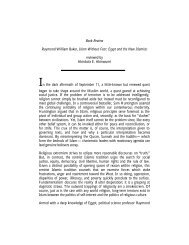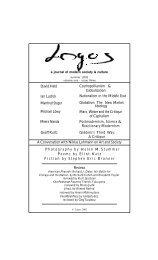Michael J. Thompson Stephen Eric Bronner Wadood Hamad - Logos
Michael J. Thompson Stephen Eric Bronner Wadood Hamad - Logos
Michael J. Thompson Stephen Eric Bronner Wadood Hamad - Logos
Create successful ePaper yourself
Turn your PDF publications into a flip-book with our unique Google optimized e-Paper software.
Abbas Amanat<br />
After the collapse of the Safavid Empire in 1736 and the ensuing political<br />
instability, Usulism reemerged as the predominant legal school in the late<br />
18th and early 19th century. In the early decades of the 19th century the<br />
Usuli jurists made evident gains in socio-economic and educational areas<br />
hence laying the foundation for a clerical establishment that continued with<br />
little interruption up to the present. They monopolized the madrasas’<br />
education and the pulpit of the mosques, controlled charitable endowments<br />
(awqaf), and posed as the only legitimate recipient of religious taxes. They<br />
developed amicable though somewhat distant relations with the early rulers<br />
of the Qajar dynasty (1785-1925), a mutually beneficial relation that brought<br />
about the golden age of Usuli ijtihad. The growth of religious circles first in<br />
Najaf, where Akhbarism was soundly defeated, and later in the Iranian cities<br />
such as Isfahan and Qum was supported with a large student body and with a<br />
closely-nit network of mater-pupil patronage. Impressive number of legal<br />
works were produced both on the specifics of the law (furu’) and on the usul<br />
al-fiqh with implicit emphasis on the role of the mujtahids not only as legal<br />
scholars but judges and social mediators. The growth of congregations in<br />
mosques also strengthened jurists’ ties with social groups in search of legal<br />
support, most noticeably the merchants of the bazaar who backed the<br />
mujtahids and financed their teaching circles in exchange for legal security<br />
and representation.<br />
Yet with all the success in developing a semi-independent legal network and a<br />
solid lay constituency, the jurists of the Qajar period did not seek to<br />
reconstruct the theory of ijtihad and its application to public law. Despite<br />
occasional “turf wars” with the state over privilege and sphere of influence, or<br />
later in defiance of the state’s Westernizing policies, they continued to honor<br />
the dichotomy of the religious law (shar’), as it concerned the jurists, versus<br />
the customary law (’urf), as exercised by the state. Neither side, the jurists or<br />
the state (at least before the rise of the European-inspired reforms) attempted<br />
to define each of these two spheres of shar’ and ’urf or demarcate their<br />
boundaries by means of codification, let alone to breach the informal<br />
boundaries between them. The usul al-fiqh remained essentially concerned<br />
with its arcane debates on the legal method and legal sources. Voluminous<br />
works, commentaries and glosses on commentaries were produced by the<br />
Usuli scholars on intricate details of semantics and epistemology. Yet the<br />
mujtahids simply did not see the need for a centralized corporate identity or<br />
for disturbing the delicate balance with the state upon which they<br />
continuously negotiated their power. The state in turn preferred ambiguity<br />
whereby through consent and coercion it hoped to persuade the jurists to<br />
<strong>Logos</strong> 2.3 – Summer 2003




